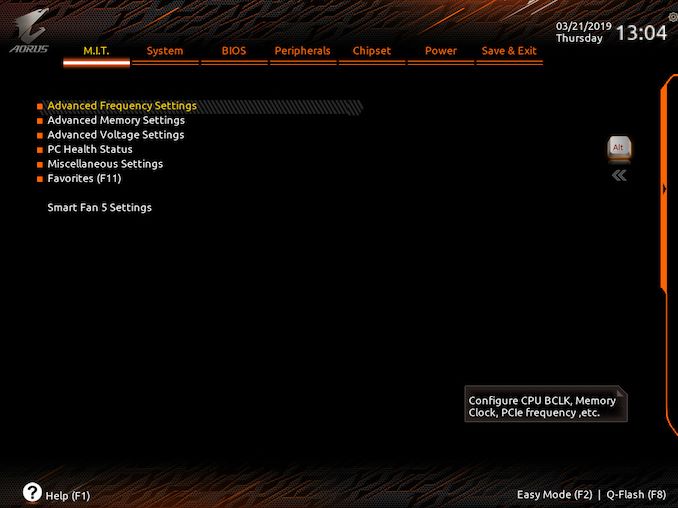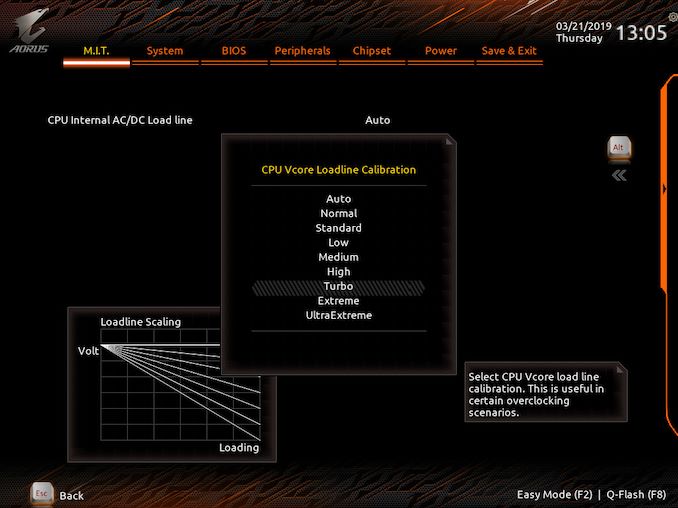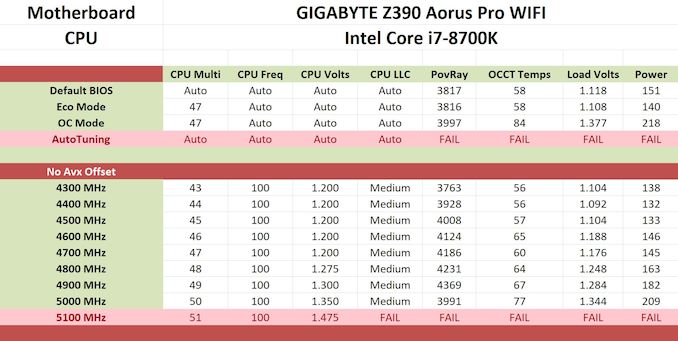The GIGABYTE Z390 Aorus Pro WIFI Motherboard Review: A Sturdy $200 Surprise
by Gavin Bonshor on April 12, 2019 10:00 AM ESTOverclocking
Experience with the GIGABYTE Z390 Aorus Pro WIFI
The GIGABYTE Z390 Aorus Pro WIFI uses 'strong and stable' firmware with a good set of customizable options for overclocking. As we found in our previous GIGABYTE Z390 Aorus Master review, overclocking using GIGABYTE's Z390 models come with their own experience and with the right settings adjusted, can overclock perfectly fine.
Each of the three main variables when it comes to overclocking (CPU, memory and voltage) each have their own menus and splitting them up allows users to not only focus overclocking on one component at a time but keeps things simple and clutter-free. Our testbed Intel Core i7-8700K processor on even the most comprehensive of motherboards has a limitation of 5.1 GHz at around 1.45 V. Above 1.35 V on the CPU VCore, we generally experience thermal throttling which is still stable, but this does have a negative impact on performance. This comes down to the board's default fan profiles as some models ramp the fans up to the maximum which does improve performance, but some do not. This creates a trade-off between computational performance, thermal performance and also acoustic performance.
With the intention of overclocking our Intel Core i7-8700K processor, the power delivery uses an Intersil ISL69138 seven channel PWM controller in a 6+1 configuration. While the in the previous GIGABYTE review we found that the voltage sensors were inaccurate, we didn't experience this issue with the Z390 Aorus Pro WIFI which made things easier. There was a slight variance between the VR VOUT sensor on the ISL69138 and what CPU-Z was reporting, it wasn't big enough to cause concern.
Overclocking Methodology
Our standard overclocking methodology is as follows. We select the automatic overclock options and test for stability with POV-Ray and OCCT to simulate high-end workloads. These stability tests aim to catch any immediate causes for memory or CPU errors.
For manual overclocks, based on the information gathered from the previous testing, starts off at a nominal voltage and CPU multiplier, and the multiplier is increased until the stability tests are failed. The CPU voltage is increased gradually until the stability tests are passed, and the process repeated until the motherboard reduces the multiplier automatically (due to safety protocol) or the CPU temperature reaches a stupidly high level (90ºC+). Our test bed is not in a case, which should push overclocks higher with fresher (cooler) air.
Overclocking Results
For the purpose of overclocking our i7-8700K on the Z390 Aorus Master, we changed the following settings which generally on other boards we've tested, have been left completely untouched. It's not unusual to disable the C-states and alter power settings when overclocking.
- CPU VCore Loadline Calibration - Medium
- All C-States - Disabled
- EIST (Intel SpeedStep Technology) - Disabled
- Intel Speed Shift - Disabled
The GIGABYTE Z390 Aorus Pro WIFI and the Easy Tune software opens up three different overclocking profiles; Eco, OC Mode and Auto Tuning. When using the Auto Tuning setting, we experienced hangs and crashes before the firmware would even initialize its cycle which means either there is an issue with the board, or the Auto Tuning overclock isn't supported on the Z390 Aorus Pro WIFI. The Eco mode applies a 4.7 GHz overclock on a single core (from six) on our i7-8700K with 1.108 V on the CPU VCore, while the OC Mode applies a 4.7 overclock across all six cores with 1.377 V on the VCore; this was too much voltage for our chip as we did hit thermal throttling which was a detriment to performance.
Manually overclocking our i7-8700K testbed processor from 4.3 GHz to 5.0 GHz was an easy task and although we had to apply the medium profile to the CPU VCore Loadline Calibration at some frequencies to get it stable, we re-tested at all the frequencies with this applied for consistency purposes. This highlights a slight issue of stability at higher frequencies such as 4.8 GHz and above with settings applied that would otherwise be fine on other boards. While adjusting the power settings, disabling C-States and applying a mid-level LLC profile did allow us to achieve 5.0 GHz stable with 1.35 V on the CPU VCore, the overall performance of this board is average, albeit competitive for the price point it's situated at. We also required more voltage for 4.9 GHz with 1.30 V on the CPU VCore which would usually net us an overclock of 5.0 GHz on better, and more premium models. Unfortunately, it is clear that the 5.0 GHz overclock was throttling during POV-Ray, so our recommendation on this chip would be 4.9 GHz.













33 Comments
View All Comments
Gayle12310 - Saturday, May 4, 2019 - link
https://mcracked.com/M Cracked is a useful place where you can easily find Full version software Free Download. Get all of these easily just on a single click.
TAfmTulsa - Saturday, June 13, 2020 - link
Good luck finding one of these, except fm a few gougers. (You might have better luck getting the Wifi ver)Jayden Andrew - Friday, August 27, 2021 - link
Great article with lots of good information but I also review this product in-depth research!https://motherboardpros.com/gigabyte-z390-aorus-pr...